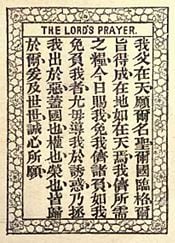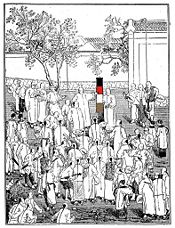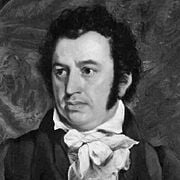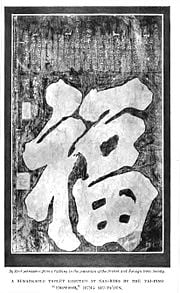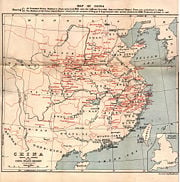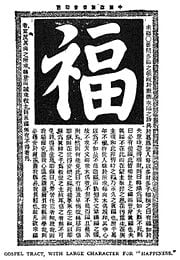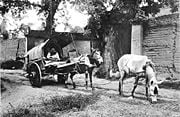Christianity in China
| This article contains Chinese text. Without proper rendering support, you may see question marks, boxes, or other symbols instead of Chinese characters. |
Christianity in China (called 基督教 Jī dū jiào, or Christ religion) is a growing minority religion that comprises Protestants, Catholics, and a small number of Orthodox Christians. Although its history in China is not as ancient as beliefs such as Confucianism, Daoism, or Mahayana Buddhism. Nestorian Christianity existed in China as early the seventh century.[1] The Nestorians were accepted in China because of their ability to adapt to China's unique cultural and religious contexts and incorporate Confucian virtues, such as loyalty and filial piety, into Christianity. The Nestorians, however, declined after heavy persecution from Emperor Wuzong of Tang (r. 840–846) who also suppressed Buddhism.
Christianity emerged in China again during the thirteenth century, when leaders of the Mongol Yuan Dynasty sought a political alliance with the Vatican, and welcomed Franciscan missionaries such as John of Montecorvino and John of Marignolli. In 1368, the new Ming Dynasty expelled all Christians, both Roman Catholic and Nestorian. In 1588, Matteo Ricci entered China, the first of a group of scholarly Jesuits who gained the patronage of the imperial court by offering scientific knowledge and adapting Christianity to the Chinese culture. Russian Orthodoxy was introduced in 1715, and the first Protestant missionary, Robert Morrison, arrived in Macao in 1807. Protestant and Catholic Christian missionaries played an important role in the modernization of China in the nineteenth and twentieth centuries, setting up schools and hospitals and translating Western works of literature and science into Chinese. Indigenous Christian movements participated in the Revolution of 1911. The Taiping Rebellion was influenced to some degree by Christian teachings, and the Boxer Rebellion was in part a reaction against Christianity in China.
The number of Christians in the People's Republic of China has increased since restrictions on religion were loosened after the 1970s. Religious practices are still often tightly controlled by government authorities. Chinese over age 18 in the PRC are permitted to be involved with officially sanctioned Christian meetings through the "China Christian Council," "Three-Self Patriotic Movement" or the "Chinese Catholic Patriotic Association."[2] Many Chinese Christians also meet in "unregistered" house church meetings.
History
Nestorianism
Christian tradition suggests that Saint Thomas, known as "the Apostle of India" or possibly Saint Bartholomew were the first to spread the Christian gospel in China. Third century Christian writer Arnobius mentions, in “Adversus Gentes,” a people known as the "Seres" which had been evangelized at that time along with the Persians and Medes. While there is evidence that Christianity existed in Mesopotamia and Persia by the early fourth century, there is no documentation that it had entered China.[3]
Following the banishment and condemnation of Nestorius, Archbishop of Constantinople, at the Council of Ephesus in 431, the form of Christianity often called Nestorianism, but known by its adherents as the Assyrian Church of the East, spread widely across the continent of Asia. Nestorianism taught that the human and divine essences of Christ are separate and that there are two natures, the man Jesus and the divine Logos, united in Christ. In consequence, Nestorians rejected such terminology as "God suffered" or "God was crucified." Likewise, they rejected the term Theotokos (Giver of birth to God/Mother of God) as a title of the Virgin Mary, suggesting instead the title Christotokos (Giver of birth to Christ/Mother of Christ), because in their view he took only his human nature from his mother, while the divine Logos was pre-existent and external, so calling Mary "Mother of God" was misleading and potentially wrong. This view was condemned at the Council of Ephesus.
A stele discovered around 1623 in Si-ngan-fu (Ch'ang-ngan), bears an inscription in Chinese and Syriac announcing that it was set up on January 7, 781, to commemorate the introduction of Christianity into China from Persia in the reign of Tang Taizong. According to the inscription, Alopen (Olopen), the Persian bishop (some scholars claim that “alopen” was merely a Chinese title meaning “monk”), arrived at Chang-an in 635 and was assigned scholars to help translate the Nestorian Sutras into Chinese. The Sutra of Jesus the Messiah, published in 638, pointed out that loyalty to the state and filial piety were of the essence of the law of Christ, and that therefore the gospel contained nothing subversive to China's ancient traditions. The emperor issued a decree proclaiming the virtue of the Nestorian religion: gave Alopen the title, “Great Spiritual Lord, Protector of the Empire;” and declared, “Let it be preached freely in our empire.”[4] The Nestorian stele goes on to say, “The religion spread throughout the ten provinces …. monasteries abound in a hundred cities.” The Nestorians earned a reputation for their skill in surgery and medicine, but allowed Chinese clergy to occupy only the lowest ranks in their monasteries, suggesting that they largely served the foreign Persian trading community. Around the same time, Nestorian Christianity entered Mongolia, and eventually reached as far as Korea. The Nestorian community in China declined after heavy persecution from Emperor Wuzong of Tang (r. 840–846), who suppressed all foreign religions, including Buddhism. Christian monks and nuns were evicted from their monasteries and forced to seek a secular living, church properties were confiscated, books and artifacts were destroyed, and foreign church leaders were made to hide or flee. A Syrian monk visiting China in 986 reported to the Patriarch that many churches were in ruins, "Christianity is extinct in China; the native Christians have perished in one way or another; the church has been destroyed and there is only one Christian left in the land."[5]
Medieval Period
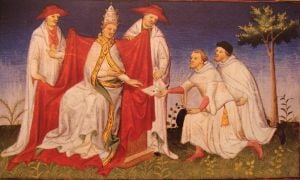
The second major thrust of Christianity into China occurred during the thirteenth century. The Mongols, under the leadership of Genghis Khan, began reaching outward from Central Asia, invading neighboring countries and incorporating them into an empire that at its height included northern China and extended westward to Persia, Mesopotamia and parts of Eastern Europe. The empire was later divided into four major divisions; the eastern-most Yuan Dynasty ruled all of China from 1279 to 1368. Nestorianism was one of the widespread religions in the empire of Genghis Khan, and the Nestorian Church experienced a significant revival during the Yuan Dynasty. Marco Polo (traveled in China 1271 – 1291) and other medieval travelers reported many Nestorian communities in China and Mongolia.
In 1271, the elder Polo brothers brought an invitation from Kublai Khan to the pope imploring him to send a hundred teachers of science and religion to his empire. The great Mongol leader concluded:
“So shall I be baptized, and when I am baptized, all my barons and lords will be baptized, and their subjects will receive baptism and so there will be more Christians here than in your own countries.”[6]
During the thirteenth century, the Papacy and the Mongols attempted to form a Franco-Mongol alliance against the Muslims in the Holy Land. The Christian Chinese Mongol, Rabban Bar Sauma, born in Beijing, visited the courts of Europe in 1287-1288, and gave a report on Christianity among the Mongols.
John of Monte Corvino
The Eastern Court under the rule of Kublai Khan was eager to secure Western assistance in its rule over the Chinese. In 1289, Pope Nicholas IV sent the Franciscan John of Monte Corvino to China by way of India. Although the great khan had already died by the time John arrived in 1294, the court at Khanbaliq received him graciously and encouraged him to settle there. John translated the New Testament and Psalms into the Mongolian language built a central church, and by 1305 reported 6000 baptized converts. He also established a lay training school of 150 students. Other priests joined him and centers were established in the coastal provinces of Kiangsu (Yangchow), Chekiang (Hangchow) and Fukien (Zaitun). In 1307, Pope Clement V named John of Montecorvino the first Archbishop of Khanbalik and Patriarch of the Orient.[7]Odorico da Pordenone (1265-1331), who arrived in Khanbaliq by way of India in 1326, spent 16 years traveling throughout China, preaching the gospel in the vernacular, and over twenty thousand converts. (Some scholars reported that by 1381, the total number of communicants exceeded 100,000.)[8]
John of Marignolli (1342-1347)
Following the death of Montecorvino, Toghun Temür, the last Mongol emperor of the Yuan dynasty, sent an embassy to the French Pope Benedict XII in Avignon in 1336, led by a Genoese in the service of the Mongol emperor, Andrea di Nascio, and his Genoese companion Andalò di Savignone.[9] Letters from the Mongol ruler represented that they had been eight years since Monte Corvino's death without a spiritual guide, and earnestly desired one. The pope replied to the letters, and appointed four ecclesiastics as his legates to the khan's court. At the same time, the Alars from the Black Sea, converted by John of Montecorvino, dispatched an embassy to Rome in 1338 to ask for a bishop.
John of Marignolli, accompanied by 50 fellow Franciscans, left Avignon that same year and reached Khanbaliq in 1342. The Yuan Dynasty annals record that he brought a gift of a Western warhorse to the emperor. In 1347, John of Marignolli left China and reached Avignon in 1353 with a letter from the great khan to Pope Innocent VI.
End of the missions
During the latter half of the fourteenth century, the Black Death in Europe so depleted Franciscan houses that they were unable to sustain the mission to China. The Yuan Dynasty began to decline, and in 1362 the last Catholic bishop of Quanzhou, Giacomo da Firenze, was killed by the Chinese who seized control of the city. The Chinese rose up and drove out the Mongols, establishing the Ming Dynasty in 1368. By 1369 the Ming Dynasty had expelled all Christians, Roman Catholic and Nestorian.
The eventual collapse of the Mongol empire into warring factions, and loss of the flourishing exchanges which the empire had made possible across the region, isolated and weakened countless churches. A new Turkic-Mongol uprising erupted in the broad reaches of Central Asia under Tamerlane (1387) and threatened both East and West. Tamerlane was a Muslim convert, and he turned with fury on Roman Christians and Nestorians.
The Franciscan friars had done most of their work with the Mongols in China, and had trained no Chinese clergy. The collapse of the Mongol Dynasty brought about the early demise of their churches. In Chinese eyes, the “religion of barbarians” was unworthy of a civilized people. In 1370, following the establishment of the Chinese Ming dynasty, a new mission was sent by the Pope to China consisting of the Parisian theologian Guillaume du Pré as the new archbishop, and 50 Franciscans. This mission disappeared without a trace.
Jesuits in China
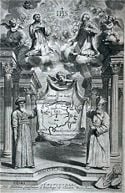
Matteo Ricci
Near the end of the Ming dynasty (1368-1644), Jesuit missionaries arrived in Beijing (Peking) via Guangzhou (Canton). The first Jesuit attempt to reach China was made in 1552 by Francis Xavier, one of the founders of the Jesuit Order, but he died the same year on the Chinese island of Shangchuan, without having reached the mainland. Before dying, he wrote to Ignatius of Loyola, “China is an extremely big country where people are very intelligent and who has many scholars… The Chinese are so dedicated to knowledge that the most educated is the most noble.”[10] After his death, numerous attempts by missionaries to enter China failed, until Father Alessandro Valignano, visitor of the Jesuit missions in the Far East, established a new method of evangelizing by adapting to national customs. In 1579, he sent Father Michele de Ruggieri to Macao, a Portuguese trading post in Southern China, with instructions to study the Mandarin language. In 1582, Matteo Ricci (1552-1610), joined him in Macao to start learning the Chinese language and customs.
Matteo Ricci had been trained as a mathematician and a scientist. He mastered the Chinese language and entered China in 1588. Ricci eventually donned the robes of a Confucian scholar, and attempted to introduce Christianity by relating it to Confucian concepts, while de Ruggieri favored the Buddhism and Daoism of the common people. The Jesuits brought with them scientific and musical instruments, clocks, prisms, paintings and architectural drawings which attracted the interest of the Chinese scholars; and studied the language, literature and etiquette of the Chinese. In 1584, Ricci published his first Chinese book: Tien Zhu Shi-lu (天主實錄 The True Account of God), discussing the existence and attributes of God, the incarnation of Christ the Word and the sacraments. In 1601 he became the first Westerner invited to enter the Forbidden City. Ricci called for other scholarly priests to join him, and trained them how to be accepted by Chinese intellectuals. The Jesuits offered scientific knowledge and advice to the Chinese court, and translated both European and Chinese classics. By 1608, the Jesuits had baptized 2000 Chinese Christians.
The last Ming empress was converted to Christianity.[11]The Jesuit influence continued into the Qing dynasty. Johann Adam Schall von Bell (Chinese: 湯若望) (1591 - 1666) was the trusted advisor of the Shunzhi emperor, and his successor as Director of Beijing Observatory and Head of the Mathematical Board, the Belgian Ferdinand Verbiest (1623-1688) became the teacher, companion and friend of the Kangxi emperor and secured his patronage for the Jesuit missions. In 1685, the French king Louis XIV sent a mission of five Jesuits "mathematicians" to China in an attempt to break the Portuguese predominance: Jean de Fontaney (1643-1710), Joachim Bouvet(1656-1730), Jean-François Gerbillon (1654-1707), Louis Le Comte (1655-1728) and Claude de Visdelou (1656-1737).[12]
Chinese Rites Controversy
In the early eighteenth century, the arrival of Franciscan and Dominican missions in the coastal cities gave rise to interorder rivalry and the Chinese Rites controversy, a dispute within the Roman Catholic Church over whether Chinese folk religion rituals and offerings to their ancestors constituted idolatry. The Jesuits, who sought to enlist the support of the Chinese literati, contended that the ceremonial rites of Confucianism and ancestor worship were primarily social and political in nature and could be practiced by converts to Christianity. The Dominicans charged that they were idolatrous; all acts of respect to Confucius and to family ancestors were nothing less than the worship of demons. Pope Clement XI eventually sided with the Dominicans, and in 1715 issued a papal bull, Ex Illa Dei, prohibiting Christian converts from performing Confucian rituals or using such terms as "Heaven," "Shangdi," and "Heavenly Lord" (Tianzhu). Disgusted with this pettiness, the Kangxi emperor circulated edicts banning Christianity, and forbidding Christian preaching. Some missionaries were expelled or persecuted. Exceptions were made for the Jesuits at the imperial court; Giuseppe Castiglioni (1688 – 1766) was appointed court painter, and Jesuits helped him to plant gardens and construct buildings and fountains for the Summer Palace. The papal decree, which was not reversed until 1939, greatly hampered the growth of the Catholic missions in China.
Protestant and Russian Orthodox missions
As a result of contact with foreign powers, further waves of missionaries came to China during the Qing (or Manchu) dynasty (1644-1911). Russian Orthodoxy was introduced in 1715.
In 1807, Robert Morrison, the first Protestant missionary to China, arrived in Macao.[13]. Morrison produced a Chinese translation of the Bible and compiled a Chinese dictionary for the use of Westerners. Morrison worked with missionaries such as Walter Henry Medhurst and William Milne (the printers), Samuel Dyer (Hudson Taylor's father-in-law), Karl Gutzlaff (the Prussian linguist), and Peter Parker (China's first medical missionary), to produce Christian literature for the merchant class, and lay the foundations for future work in education and medicine.
Protestants record that Tsae A-Ko, baptized by Robert Morrison at Macau around 1814. was the first known Chinese Protestant Christian[14].
Taiping Rebellion
The bloody Taiping Rebellion, a large-scale revolt against the Qing Government, was conducted from 1850 to 1864 by an army and civil administration led by heterodox Christian convert Hong Xiuquan. Believing that he was the younger brother of Jesus Christ, Hong Xiuquan established a "Heavenly Kingdom of Great Peace" with its capital at Nanjing, and attained control of significant parts of southern China, ruling over about 30 million people at the height of the rebellion. The theocratic and militaristic regime instituted several social reforms, including strict separation of the sexes, abolition of foot binding, land socialization, suppression of private trade, and the replacement of Confucianism, Buddhism and Chinese folk religion by a form of Christianity. The Taiping rebellion, which was eventually put down by the Qing army aided by French and British forces, ranks among history's deadliest conflicts, with an estimated death toll of between 20 and 30 million due to warfare and resulting starvation.[15]
Protestant expansion
In 1800 there had been 250,000 baptized Roman Catholics, but no known Protestant believers out of an estimated 362 million Chinese. By 1949, out of an estimated population of 450 million, there were just over 500,000 baptized Protestant Christians.[16]
The earliest missionary group from the United States was the American Board (Congregationalist), but it was soon followed by numerous organizations from the U.S., England and the European continent. During the 1840s, Western missionaries spread Christianity rapidly through the coastal cities that were open to foreign trade. In the early 1860s, when the Taiping movement was almost extinct, Protestant missions were confined to five coastal cities. In 1864, there were less than 200 Protestant missionaries in China; by 1890, there were 1300.[17] By the end of the century, scores of new missionary societies had been organized, and several thousand missionaries were working in all parts of China. This transformation can be traced to the Unequal Treaties which forced the Chinese government to admit Western missionaries into the interior of the country, the excitement caused by the 1859 Awakening in Britain and the example of J. Hudson Taylor (1832-1905).
By 1865, when the China Inland Mission began, there were already thirty different Protestant groups at work in China[18] In the seven provinces where Protestant missionaries had already been working, there were an estimated 91 missionaries for 204 million people, while nothing had been attempted in the eleven other provinces in inland China, with a population estimated at 197 million.[19]. Besides the London Missionary Society, and the American Board of Commissioners for Foreign Missions, there were missionaries affiliated with Baptists, Southern Baptists, Presbyterians, Methodists, Episcopalians, and Wesleyans. Most missionaries came from England, the United States, Sweden, France, Germany, Switzerland, or Holland[20].
In addition to the publication and distribution of Christian literature and Bibles, the Protestant Christian missionary movement in China furthered the dispersion of knowledge with other printed works of history and science. Timothy Richard (1832 – 1919) and the Christian Literature Society provided translations of secular as well as religious works. The colloquial written language of the ordinary people appeared in print for the first time in translations of the Bible; previously all literary works had been in classical Chinese, accessible only to scholars. This contributed to the Chinese literary renaissance, beginning in 1915, that emphasized the use of the vernacular in literature.[21]
As the missionaries went to work among the Chinese, they established and developed schools and introduced the latest techniques in medicine[22] The mission schools were viewed with some suspicion by the traditional Chinese teachers, but they differed from tradition by offering a basic education to poor Chinese, both boys and girls, who otherwise had no hope of learning at a school.[23] Yanjing University in Beijing, and its affiliated Harvard-Yenjing Institute, helped to raise the standards for modern education.
Christians in China established the first modern clinics and hospitals[24], and provided the first modern training for nurses. Both Roman Catholics and Protestants founded numerous educational institutions in China from the primary to the university level. Some of the most prominent Chinese universities began as religious institutions. Missionaries provided training in engineering, agriculture and science, and set up orphanages and institutions for the blind and the insane.
Missionaries worked to abolish practices such as foot binding which crippled women[25], and the unjust treatment of maidservants, as well as launching charitable work and distributing food to the poor. They also opposed the opium trade[26] and offered treatment to addicts.
China Inland Mission
In 1854, Hudson Taylor arrived in China. Historian Kenneth Scott Latourette wrote that "Hudson Taylor was, …one of the greatest missionaries of all time, and … one of the four or five most influential foreigners who came to China in the nineteenth century for any purpose…." The China Inland Mission was the largest mission agency in China, and it is estimated that Taylor was responsible for more people being converted to Christianity than at any other time since Paul the Apostle brought Christian teaching to Europe. Out of the 8500 Protestant missionaries that were at one time at work in China, 1000 of them were from the CIM[27]. Dixon Edward Hoste, the successor to Hudson Taylor, was the first to articulate the self-governing principles of the Three-Self Patriotic Movement, a reflection of the goal of the China Inland Mission to establish an indigenous Chinese church that was free from foreign control.
Boxer Rebellion
Unemployment and discontent among the Chinese peasantry gave rise to the Boxer Rebellion, starting in Shandong in 1898 and spreading over North China. The main focus of the rebellion became resentment against foreign influence, especially against Christianity. Missionaries and Christian converts were massacred, and eventually the rebels, backed by imperial troops, besieged the Legation Quarter in Beijing and killed Chinese Christians who had gone there to seek refuge. An international force commanded by a German field marshal defeated the rebels and punished many northern cities. Heavy terms were imposed on China, the Russians occupied Manchuria, and the ancient system of civil service examinations was ended.
Twentieth century to the present
Popularity and indigenous growth (1900-1925)
Reaction to the failures of nineteenth century reform movements and to the international humiliation following the Boxer Rebellion helped create a readiness for change. Many Chinese sought to modernize China by importing and adapting technology and cultural concepts from the West. Since missionaries contended that Western progress derived from its Christian heritage, Christianity gained new favor. The missionaries, their writings and Christian schools were accessible sources of information; parochial schools filled to overflowing. Church membership expanded and Christian movements like the YMCA and YWCA became popular. The Manchurian revival (1908) that swept through the churches of present day Liaoning Province during the ministry of Canadian missionary, Jonathan Goforth, was the first such revival to gain nationwide publicity in China as well as internationally.[28].
By 1925, the number of Protestant missionaries in China had surpassed 8000, and in the process, the nature of the Christian community had altered. Estimates for the Chinese Protestant community ranged around 500,000. British and American denominations, such as the British Methodist Church, continued to send missionaries until they were prevented from doing so following the establishment of the People's Republic of China. Protestant missionaries played an extremely important role in introducing knowledge of China to the United States and the United States to China. The book The Small Woman and film Inn of the Sixth Happiness tell the story of one such missionary, Gladys Aylward.
There were also growing numbers of conservative evangelicals. Some came from traditional denomination, but others worked independently with minimal support, and many were sponsored by fundamentalist and faith groups like the Seventh-day Adventist Church, the Christian Missionary Alliance, and the Assemblies of God. Pentecostal, charismatic and Millenarian preachers brought a new zeal to the drive to evangelize the world.
Parochial schools nurtured a corps of Christian leaders who acquired influential positions in education, diplomatic service and other government bureaus, medicine, business, the Christian church and Christian movements. The development of modern Chinese Christianity was influenced by thinkers like Yu Rizhang (David Yui 1882 - 1936), Zhao Zichen (趙紫宸, 1888-1989), Xu Baoqian (徐寶謙, 1892-1944), and Liu Tingfang (Timothy Liu, 劉廷芳, 1890-1947), characterized by their liberal theology, commitment to social reform, deep Chinese patriotism, and acquaintance with Western learning. Many of these leaders held popular revival meetings in Christian schools throughout China and, along with conservative churchmen like Cheng Jingyi (1881-1939), sparked the drive for greater Chinese autonomy and leadership in the church.
These leaders became Chinese spokesmen in the National Christian Council, a liaison committee for Protestant churches, and the Church of Christ in China (CCC), established in 1927 to work toward independence. Progress toward autonomy was slow because Western mission boards were reluctant to relinquish financial control, which gave them a decisive voice in most matters of importance.
Some of the early leaders of the Chinese Republic, such as Sun Yat-sen were converts to Christianity and were influenced by its teachings[29].
Autonomous churches
The proliferation of completely autonomous Chinese Christian churches and communities was a new phenomenon in Chinese Protestantism. By 1920 the China Christian Independent Church (Zhōngguó Yēsūjiào Zìlìhuì) federation had over 100 member churches, drawn mostly from the Chinese urban class. In contrast, the Pentecostal, millenarian and exclusivist True Jesus Church (Zhēn Yēsū Jiàohuì), founded in 1917, concentrated in the central interior provinces.
Sometimes independence derived not so much from a desire to indigenize Christianity as from the nature of leadership. Wang Mingdao (1900-1991) and Song Shangjie (John Sung, 1900-1944) were zealous, confident of possessing the truth, and critical of what they perceived as lukewarm formalism in the Protestant establishments. They drew on the revivalism and mysticism of Western “faith sects” and the Pentecostalism of the True Jesus Church. During the 1920s and 1930s both Wang and Song worked as independent itinerant preachers, holding highly successful and emotional meetings in established churches and other venues. Their message was simple: “today’s evil world demands repentance; otherwise hell is our destiny.” Their premillennial eschatology attracted tens of thousands of followers set adrift in an environment of political chaos, civil war, and personal hardship.
Era of national and social change, the Japanese Occupation Period (1925-1949)
In the aftermath of World War I, and the economic hardship of the Great Depression, support for missionary activities declined. These difficulties accelerated indigenization of Christian churches in China.
The Japanese invasion of Manchuria in 1931 presented a dilemma for many Chinese Christian leaders, who were internationalists and pacifists. Most abandoned their pacifism, and many joined the National Salvation Movement. After the Pearl Harbor attack in December, 1941, Japan invaded much of China and the Pacific region, and most Westerners were evacuated or interned. During World War II, Christian churches and organizations had their first experience with autonomy from the Western-guided structures of the missionary church organizations. The Chinese Protestant church moved toward independence, union, or Chinese control. Some scholars suggest that this period helped lay the foundation for the independent denominations and churches of the post-war period, and the eventual development of the Three-Self Church (self-government, self-support, and self-propagation) and the Chinese Catholic Patriotic Association (CCPA).
When World War II ended, the Chinese Civil War affected the rebuilding and development of the churches. The chaos in China during the 1930s and 1940s spawned religious movements that emphasized direct spiritual experience and an eschatology offering hope and comfort beyond this cruel world. In opposition to the "Y" and the Student Christian Movement, conservatives organized the Intervarsity Christian Fellowship in 1945. The Jesus Family (Yēsū Jiātíng), founded around 1927, expanded in rural north and central China. Communitarian, pentecostal, and millenarian, its family communities lived, worked and held property jointly; worship often included speaking in tongues and revelations from the Holy Spirit.
The salvationist promise of Wang Mingdao, John Sung, and Ji Zhiwen (Andrew Gih/計志文, 1901-1985) continued to attract throngs of followers, many of them already Christians. Ni Tuosheng (Watchman Nee, 1903-1972), founder of the Church Assembly Hall (nicknamed "Little Flock"), drew adherents with assurances of a glorious New Jerusalem in the next life for those who experienced rebirth and adhered to a strict morality. By 1945, the local churches claimed a membership of over 70,000, spread among some 700 assemblies.[30] Together, the independent churches accounted for well over 200,000 Protestants.
Communist rule
The People's Republic of China was established in October, 1949, by the Communist Party of China, led by Mao Zedong. Under Communist ideology, religion was discouraged by the state, and over the next three decades Christians endured widespread persecution by authorities.
Between 1949 and 1952, all foreign missionaries left the country in what was described by Phyllis Thompson of the China Inland Mission as a "reluctant exodus," leaving the indigenous churches to manage their own administration, support, and propagation of the faith. The Chinese Protestant church entered the communist era having made significant progress toward self-support and self-government. Chinese rulers had always sought to regulate organized religion, and the Chinese Communist Party continued the practice, but Chinese Christians were experienced in accommodating the government in order to protect its members.
During the Cultural Revolution (1966 to 1976), all expression of religious life in China was effectively banned, including even the Three-Self Patriotic Movement. Believers were arrested and imprisoned and sometimes tortured for their faith[31]. Bibles were destroyed, churches and homes were looted, and Christians were subjected to humiliation. All Chinese Christian worship was driven underground to escape persecution, resulting in the growth of the Chinese house church movement which had begun in 1949. In 1979, to counter this growing trend of "unregistered meetings," the government officially restored the Three-Self Patriotic Movement after thirteen years of non-existence[32], and in 1980 the CCC was formed.
In 1993, the TSPM had 7 million registered members and 11 million affiliated members, compared to an estimated 18 million and 47 million "unregistered" Protestant Christians respectively.
Persecution of Christians in China has been sporadic. The most severe persecution took place during the Cultural Revolution. Several thousand Christians were known to have been imprisoned between 1983-1993[33]. In 1992 the government began a campaign to shut down all of the unregistered meetings; however, government implementation of restrictions since then has varied widely between regions of China and in many areas there is greater religious liberty than before.
Christianity in the contemporary PRC
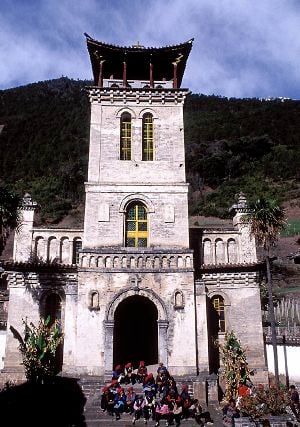
Official Christian organizations
Since restrictions on religion were loosened after the 1970s, Christianity has grown significantly within the People's Republic. It is still, however, tightly controlled by government authorities. Chinese over the age of 18 are permitted to join the Three-Self Patriotic Movement, China Christian Council (Protestant), or the Chinese Patriotic Catholic Association, which has disavowed the Pope and the authority of the Vatican, and is considered schismatic by other Roman Catholics. These organizations have affiliations with government and must follow the regulations imposed upon them.
House churches
Many Christians choose to meet independently of these organizations, typically in house churches. These fellowships are not officially registered and are often persecuted as illegal entities. Their members and leaders are sometimes harassed by local government officials[34] and punished with prison sentences or, more commonly, “re-education” through labor. Heavy fines are not uncommon, and personal effects are confiscated if they are not paid. House churches have not been formally outlawed, and since the 1990s, there has been increasing official tolerance of house churches in some regions. Reports of sporadic persecution against such Christians in Mainland China have caused concern among outside observers[35].
In the 1970s, some informal groups emerged that seem to either have been wholly new in origin, or to have been a new manifestation of an older movement. One of the best documented of these groups was founded by Peter Xu, an independent evangelist who began preaching in Henan in 1968. His organization, variously called the "New Birth Sect" (重生派), the "Total Scope Church" (全范围教会), or the “Criers,” strongly emphasis on a definitive experience of conversion, usually during an intensive three-day "life meeting." Xu claims that his organization consists of over 3500 congregations in more than 20 of China's provinces. Several other organized networks claim a similarly large number of adherents.
Orthodox Christianity in China
There are a small number of adherents of Russian Orthodoxy in northern China, predominantly in Harbin. The first mission was undertaken by Russians in the seventeenth century. Orthodox Christianity is also practiced by the small Russian ethnic minority in China. The Church operates relatively freely in Hong Kong (where the Ecumenical Patriarch has sent a metropolitan, Bishop Nikitas, and the Russian Orthodox parish of Saint Peter and Saint Paul has resumed its operation) and Taiwan (where archimandrite Jonah George Mourtos leads a mission church). The Evenks of both the Russian Federation and the People's Republic of China, along with a few other tribes in Siberia and in China, are among the only Asiatic peoples who nominally practice Orthodox Christianity, which they voluntarily adopted during contacts from Russian expansion into Siberia. There are also around 3000 Evenks in neighboring Heilongjiang Province.
Some Chinese terms in Christianity
Various terms are used for God in the Chinese language. The most prevalent is Shangdi (上帝, literally, "Sovereign King Above"), commonly used by Protestants and also by non-Christians, and Tianzhu (天主, literally, Lord of Heaven), which is most commonly favored by Catholics.
While Christianity is referred to as 基督教 (Christ religion), the modern Chinese language typically divides Christians into three groups: followers of Protestantism Xin jiaotu (新教徒, literally "new religion followers"), followers of Catholicism Tianzhu jiaotu (天主教徒, Lord of Heaven religion followers), and followers of Orthodox Christianity, Dongzheng jiaotu (東正教徒, Eastern Orthodox religion followers, or more correctly, "zhengjiaotu" 正教徒). Eastern Orthodox churches are not in communion with the Oriental Orthodox churches.
Demographics/Geography
It is not known exactly how many Chinese consider themselves Christian. In 2000, the People's Republic of China government census enumerated 4 million Chinese Catholics and 10 million Protestants[36]. The Chinese government once stated that only 1 percent (13 million) [37] of the population is Christian, while the Chinese Embassy in Washington, DC, officially states that 10 million[38]Chinese (0.75 percent of the total population) are Christian. In October, 2007, two independent surveys, one conducted by Protestant missionary Werner Burklin, the other one by Liu Zhongyu from East China Normal University in Shanghai, arrived at the same conclusion,[39]that there are roughly 54 million Christians in China, of which 39 million are Protestants and 14 million are Catholics. The CIA World Factbook, using an estimate from 2002, indicates that about 3 percent to 4 percent of all the population in China are Christians.[40]
The official 2002 count of members of Official Protestant churches was about 15 million, while some estimates on the number of members of Chinese house churches vary from 50 million to 100 million. Independent estimates have ranged from 40 million[41], to 100 million[42], or even 130 million Christians in January 2007 (out of a total population of at least 1.3 billion people).[43][44]
Kiven Choy stated, in a Chinese weekly newspaper in Hong Kong, that the correct number of Protestants in China should be at around 20 million, while TIME Magazine recently reported 65 million.[45]
There are 4 million members of the Chinese Patriotic Catholic Association and an estimated 12 million members of the underground Roman Catholic Church in China as of 2006.[46]
Between 1949 and 2001, indigenous Chinese Christianity has been growing at an unprecedented rate[47][48]. [49]" Most of the growth has taken place in the unofficial Chinese house church movement.[50]
A relatively large proportion of Christians, particularly Catholics, is concentrated in Hebei province. Hebei is also home to the town of Donglu, site of an alleged Marian apparition and pilgrimage center.
Christianity in Hong Kong
Christianity has been in Hong Kong since 1841. Among approximately 660,000 Christians in Hong Kong, most are traditional Protestant denominations and Roman Catholics.
Christianity in the "Autonomous Regions"
Among the Uygur, who are predominantly Muslim, very few are known to be Christian. In 1904 George Hunter with the CIM opened the first mission station in Xinjiang. By the 1930s there existed some churches among this ethnic group, but violent persecution destroyed the churches and scattered the believers.[51].
The Hui people, who live in nearly every part of China, and make up about 30 percent of the population of Ningxia, are almost entirely Muslim and very few are Christian.
Rapid church growth is reported to have taken place among the Zhuang people during the early 1990s[52]. The predominantly Buddhist and animistic region of Guangxi was first visited in 1877 by Protestant missionary Edward Fishe of the CIM, who died the same year.
Tibet (Xizang Zizhiqu)
Tibet, once a theocratic Buddhist state, has largely resisted Christian influences. At the beginning of the twenty-first century there are very few Tibetan Christians[53], although recent historical research indicates the presence of some form of Christianity as early as the sixth and seventh centuries in Tibet, a period when the White Huns had extensive links with the Tibetans.
The first European traveler who appears to have visited Lhasa is the Franciscan Odoric of Pordenone in the first half of the fourteenth century. He was followed by the Jesuits in 1624.[54]
In the years 1630 and 1742, Tibetan Christian communities were suppressed by the lamas of the Gelugpa Sect, whose chief lama was the Dalai Lama. Jesuit priests were made prisoners in 1630, or attacked before they reached Tsaparang. Between 1850 and 1880 eleven fathers of the Paris Foreign Mission Society were murdered in Tibet, or killed or injured during their journeys to other missionary outposts in the Sino-Tibetan borderlands. In 1881, Father Brieux was reported to have been murdered on his way to Lhasa. Qing officials later discovered that the murders were covertly supported and even orchestrated by local lamaseries and their patrons, the native chieftains.
In 1877 the British Protestant missionary James Cameron of the China Inland Mission walked from Chongqing to Batang Town, Sichuan, to bring the Gospel to the Tibetan people.
In 1904, Qing official Feng Quan sought to curtail the influence of the Gelugpa Sect and ordered the protection of Western missionaries and their churches. Indignation over Feng Quan and the Christian presence escalated to a climax in March 1905, when thousands of the Batang lamas revolted, killing Feng, his entourage, local Manchu and Han Chinese officials, and the local French Catholic priests. The revolt soon spread to other cities in eastern Tibet, such as Chamdo, Litang and Nyarong, and almost spilled over into neighboring Sichuan Province. Angry Gelugpa monks and local chieftains burned and destroyed the missionary stations and churches in these areas, and dozens of Westerners, including at least four priests, were killed or wounded. When panicked Qing authorities hurriedly sent 2000 troops from Sichuan to pacify the mobs, the revolt gradually came to an end. Among the lamasery authorities and local native chieftains, hostility towards the Western missionaries in Tibet lingered through the last throes of the Manchu dynasty and into the Republican period.[55]
In 1993 it was reported that there were a few congregations of Tibetan Christians now living in India[56].
International visitors and Christianity
In large, international cities such as Beijing[57], foreign visitors have established Christian church communities which meet in public establishments such as hotels. These churches and fellowships are typically restricted only to holders of non-Chinese passports.
American officials visiting China have on multiple occasions visited Chinese churches. President George W. Bush attended one of Beijing's five officially-recognized Protestant churches during a November, 2005, Asia tour.[58]. Secretary of State Condolezza Rice attended Palm Sunday services in Beijing in 2005.
Notes
- ↑ Alvyn Austin. 2007. China’s Millions: The China Inland Mission and Late Qing Society. (Grand Rapids, MI: Eerdmans, ISBN 978-0802829757)
- ↑ Patrick Johnstone. (1993) 2001. Operation World, 21st Century Ed. (London: Paternoster. ISBN 1850783578), 165
- ↑ Henri Cordier, The Church in China. The Catholic Encyclopedia, Vol. 3. (New York: Robert Appleton Company, 1908) NewAdvent.com. Retrieved July 1, 2008
- ↑ Cordier, The Church in China, The Catholic Encyclopedia. 1908. NewAdvent.com. Retrieved July 1, 2008.
- ↑ China View, 2008-02-27, Research: Christianity popular among China's Tang Dynasty citizens. Xinhua. accessdate 2008-07-02
- ↑ Richard Foltz. Religions of the Silk Road: overland trade and cultural exchange from antiquity to the fifteenth century. (New York: St. Martin's Griffin. 2000. ISBN 0312233388), 131
- ↑ Foltz, 131
- ↑ Foltz, 131.
- ↑ Peter Jackson. The Mongols and the West: 1221-1410. (New York: Longman, 2005. ISBN 978-0582368965), 314
- ↑ Jean Lacoutre, Jesuits: A Multibiography. (Harvill, 1996), 244. (in English). ASIN: B000NEXBQI.
- ↑ W. Scott Morton and Charlton M. Lewis. “China, Its History and Culture.” (New York: McGraw-Hill Inc., 1995), 141
- ↑ Catherine Pagani. Eastern Magnificence and European Ingenuity: Clocks of Late Imperial China. (Ann Arbor: University of Michigan Press, 2001), 182
- ↑ Johnstone, 2001, 164
- ↑ Horne (1904), Chapter 5
- ↑ Paul Halsall, "Chinese Hitory," Compiled from Compton's Living Encyclopedia on America Online (August 1995), Chinese Cultural Studies: Concise Political History of China
- ↑ Latourette, 1929
- ↑ Morton and Lewis, 164
- ↑ Spence (1991), 206
- ↑ James Hudson Taylor. (1868) China's Spiritual Need and Claims, Third Ed. (London: James Nisbet)
- ↑ Jonathan D. Spence. The Search for modern China. (New York: W. W. Norton & Company, 1991. ISBN 0393307808), 206
- ↑ Hist., p. 166
- ↑ Spence, 1991, 206.
- ↑ Spence, 1991, 208.
- ↑ Edward V. Gulick. "Peter Parker and the Opening of China." Journal of the American Oriental Society 95 (3) (Jul.-Sep., 1975): 561-562
- ↑ Alan Burgess. The Small Woman. (1957. ISBN 1568491840), 47
- ↑ Austin, 2007
- ↑ Johnstone, 2001, 164
- ↑ Edith Waldvogel Blumhofer. Modern Christian Revivals. (University of Illinois Press, 1993. ISBN 0252019903), 162
- ↑ Irma Tam Soong, "Sun Yat-sen's Christian Schooling in Hawai'i." The Hawaiian Journal of History 13 (1997): 151-178
- ↑ Paul E. Kauffman. China Yesterday. (Hong Kong: Asian Outreach, 1975), 100-101.
- ↑ Johnstone, 2001, 168
- ↑ Johnstone, 2001, 164
- ↑ Johnstone, 2001, 168
- ↑ The Truth About China Open Doors UK. Retrieved July 2, 2008.
- ↑ China's Christians suffer for their faith. BBC News, 2004-11-09.
- ↑ China in Brief, China in Brief-Religions and Social Customs china.org.cn. Retrieved July 3, 2008.
- ↑ Survey finds 300m China believers BBC News, Asia-Pacific, Retrieved July 3, 2008.
- ↑ China Refutes Distortions about Christianity. China Embassy. Retrieved July 3, 2008.
- ↑ China Survey Reveals Fewer Christians than Some Evangelicals Want to Believe. Assist News Retrieved July 3, 2008.
- ↑ CIA - The World Factbook - China.
- ↑ BBC NEWS Survey finds 300m China believers. BBC News Asia Pacific, Retrieved July 3, 2008.
- ↑ Jerry Dykstra, Freedom, Key Chinese House Church Leader's Testimony. Christian Broadcast Network CBN.com. Retrieved July 3, 2008.
- ↑ The Religion Report - 8 August 2007 - China Missionaries expelled The Religion Report ABC Australia. Retrieved July 3, 2008.
- ↑ US Dept of State, China (includes Hong Kong, Macau, and Tibet) International Religious Freedom Report 2007. Retrieved July 3, 2008.
- ↑ Simon Elegant, The War For China's Soul. TIME Magazine, August 20, 2006. Retrieved July 3, 2008.
- ↑ Taipei Times, Editorial: China's latest war on religion. May 7, 2006, Retrieved July 3, 2008.
- ↑ Johnstone, 2001, 164
- ↑ Counting Christians in China: a cautionary report. from International Bulletin of Missionary Research, 01-JAN-03. goliath. Retrieved July 4, 2008
- ↑ Nicholas D. Kristof, a columnist of the New York Times wrote on June 25, 2006, "Although China bans foreign missionaries and sometimes harasses and imprisons Christians, especially in rural areas, Christianity is booming in China. Church growth in China. (Century marks) Retrieved July 4, 2008
- ↑ Spengler speculated in 2007 that Christianity could "become a Sino-centric religion two generations from now." Christianity finds a fulcrum in Asia. Asia Times Online, 2007-08-07, accessdate 2008-07-04
- ↑ Johnstone, 2001, 167
- ↑ Johnstone, 2001, 168
- ↑ Johnstone, 2001, 167
- ↑ H. Cordier & J. Lenhart, Catholic Encyclopedia Article on Tibet. The Catholic Encyclopedia, (1912). Newadvent. Retrieved July 3, 2008
- ↑ Lin Hsiao-ting, Pacific Rim Report. When Christianity and Lamaism Met: The Changing Fortunes of Early Western Missionaries in Tibet, Retrieved July 3, 2008.
- ↑ Johnstone, 2001, 167
- ↑ Beijing International Christian Fellowship, BICF Retrieved July 2, 2008.
- ↑ Bush Attends Beijing Church, Promoting Religious Freedom Washington Post (November 20, 2005) Retrieved July 3, 2008.
ReferencesISBN links support NWE through referral fees
- Aikman, David. 2004. Jesus in beijing: how Christianity is transforming china and changing the global. [S.l.]: Regnery Gateway. ISBN 0895260794.
- Austin, Alvyn. China’s Millions: The China Inland Mission and Late Qing Society, 1832-1905, edited by Robert Eric Frykenberg and Brian Stanley. Grand Rapids, MI: Eerdmans, 2007. ISBN 9780802829757.
- Bays, Daniel H. Christianity in China: from the eighteenth century to the present. Stanford, CA: Stanford University Press, 1996. ISBN 0804726094.
- Blumhofer, Edith Waldvogel. Modern Christian Revivals. University of Illinois Press, 1993. ISBN 0252019903.
- Burgess, Alan. The Small Woman. (1959) reprint ed. Buccaneer Books, 1993. ISBN 1568491840.
- Fairbank, John King. The missionary enterprise in China and America. (Harvard studies in American-East Asian relations, 6) Cambridge, MA: Harvard University Press, 1974. ISBN 0674576551.
- Foltz, Richard. Religions of the Silk Road: overland trade and cultural exchange from antiquity to the fifteenth century. New York: St. Martin's Griffin. 2000. ISBN 0312233388
- Foster, John. The church of the T'ang dynasty. London: Society for Promoting Christian Knowledge/Macmillan, 1939.
- Gulick, Edward V. Peter Parker and the Opening of China. (Harvard Studies in American-East Asian Relations) Cambridge, MA: Harvard University Press, 1974. ISBN 0674663268.
- Hayward, Victor E. W., Christians and China. Belfast: Christian Journals Ltd., 1974. ISBN 0904302040.
- Hunter, Edward. The story of Mary Liu, the Triumphant Life Story of a Chinese girl who endured Dire Physical Handicaps & Political Persecution. New York: Farrar, Straus and Cudahy, 1957.
- Jackson, Peter. The Mongols and the West: 1221-1410. New York: Longman, 2005. ISBN 978-0582368965.
- Johnstone, Patrick. (1993) 2001. Operation World, 21st Century Ed. London: Paternoster. ISBN 1850783578.
- Lacoutre, Jean. Jesuits: A Multibiography. (Harvill, 1996), 244. (in English). ASIN: B000NEXBQI
- Lambert, Tony. China's Christian millions. Oxford, UK: Monarch, 2006. ISBN 1854247484.
- Lambert, Tony. Counting Christians in China: a cautionary report: An article from: International Bulletin of Missionary Research. 2005.
- Lambert, Tony. The resurrection of the Chinese church. (An OMF book) Wheaton, IL: Harold Shaw Publishers, 1994. ISBN 0877887284.
- Latourette, Kenneth Scott. A History of Christian Missions in China. 1929.
- Lee Shiu Keung. The Cross and the Lotus. Hong Kong: Christian Study Centre on Chinese Religion and Culture, 1971.
- Lyall, Leslie T. Come wind, come weather; the present experience of the church in China. Chicago: Moody Press, 1960.
- Lyall, Leslie T. Red sky at night: Communism confronts Christianity in China. London: Hodder & Stoughton, 1969. ISBN 0340108169.
- Morton, W. Scott, and Charlton M. Lewis. China, Its History and Culture. New York: McGraw-Hill Inc., 1995.
- Outerbridge, Leonard M. The lost churches of China. Philadelphia: Westminster Press, 1952.
- Pagani, Catherine. Eastern Magnificence and European Ingenuity: Clocks of Late Imperial China. Ann Arbor: University of Michigan Press, 2001. ISBN 0472112082.
- Patterson, George N. Christianity in China. London: World Books, 1969.
- Rees, D. Vaughan. The "Jesus family" in communist China; a modern miracle. Greenwood, SC: Attic Press, 1976. ISBN 087508463X.
- Sih, Paul K. T. Decision for China: Communism or Christianity. (Asia in the Modern World no. 10.) (1959) reprint New York: St. John's University Press, 1971.
- Sites, Sarah Moore. Nathan Sites; an epic of the East. New York: Fleming H. Revell Co., 1912.
- Song, Choan-Seng. The believing heart: an invitation to story theology. Minneapolis, MN: Fortress Press, 1999. ISBN 0800631420.
- Soong, Irma Tam. "Sun Yat-sen's Christian Schooling in Hawai'i." The Hawaiian Journal of History 13 (1997).
- Spence, Jonathan D. The memory palace of Matteo Ricci. London: Penguin Non-classics, 1985. ISBN 0140080988.
- Spence, Jonathan D. The Search for modern China. W. W. Norton & Company. 1991. ISBN 0393307808.
- Suman, Michael D. The Church in China: one Lord two systems. Bangalore, India: SAIACS Press, 2006. ISBN 8175256931.
- Taylor, James Hudson. China's Spiritual Need and Claims, Third Ed. London: James Nisbet. 1868.
- Yeo, Khiok-Khng. What has Jerusalem to do with Beijing: biblical interpretation from a Chinese perspective. Harrisburg, PA: Trinity Press International, 1998. ISBN 1563382296.
External links
All links retrieved February 18, 2017.
- Biographical Dictionary of Chinese Christianity
- NewAdvent.org Catholic Encyclopedia
- Surveys/analyses of religious freedom in China by Forum 18 News Service
- Methodist Missions in China
- Chinese Bible Resources
- OMF International (formerly China Inland Mission and Overseas Missionary Fellowship)
| ||||||||||||||||||||||||||||
Credits
New World Encyclopedia writers and editors rewrote and completed the Wikipedia article in accordance with New World Encyclopedia standards. This article abides by terms of the Creative Commons CC-by-sa 3.0 License (CC-by-sa), which may be used and disseminated with proper attribution. Credit is due under the terms of this license that can reference both the New World Encyclopedia contributors and the selfless volunteer contributors of the Wikimedia Foundation. To cite this article click here for a list of acceptable citing formats.The history of earlier contributions by wikipedians is accessible to researchers here:
- Christianity_in_China history
- Nestorianism_in_China history
- Medieval_Roman_Catholic_Missions_in_China history
- Johann_Adam_Schall_von_Bell history
- Ferdinand_Verbiest history
- Chinese_house_church history
- Nestorianism history
The history of this article since it was imported to New World Encyclopedia:
Note: Some restrictions may apply to use of individual images which are separately licensed.
